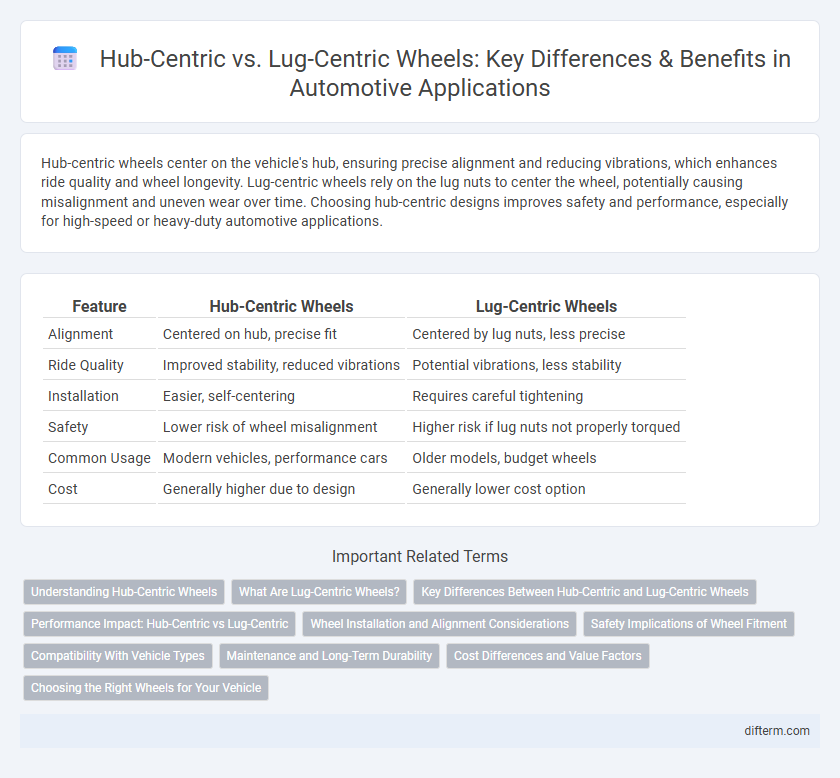Hub-centric wheels center on the vehicle's hub, ensuring precise alignment and reducing vibrations, which enhances ride quality and wheel longevity. Lug-centric wheels rely on the lug nuts to center the wheel, potentially causing misalignment and uneven wear over time. Choosing hub-centric designs improves safety and performance, especially for high-speed or heavy-duty automotive applications.
Table of Comparison
| Feature | Hub-Centric Wheels | Lug-Centric Wheels |
|---|---|---|
| Alignment | Centered on hub, precise fit | Centered by lug nuts, less precise |
| Ride Quality | Improved stability, reduced vibrations | Potential vibrations, less stability |
| Installation | Easier, self-centering | Requires careful tightening |
| Safety | Lower risk of wheel misalignment | Higher risk if lug nuts not properly torqued |
| Common Usage | Modern vehicles, performance cars | Older models, budget wheels |
| Cost | Generally higher due to design | Generally lower cost option |
Understanding Hub-Centric Wheels
Hub-centric wheels center precisely on the vehicle hub, ensuring the wheel's weight is evenly distributed and reducing stress on the lug nuts compared to lug-centric wheels, which rely solely on the lug nuts for alignment. This precise fit minimizes vibrations, enhances ride quality, and improves overall vehicle safety by maintaining proper wheel alignment under various driving conditions. Automotive manufacturers often prefer hub-centric designs for high-performance and luxury vehicles to achieve superior handling and durability.
What Are Lug-Centric Wheels?
Lug-centric wheels are designed to be centered by the lug nuts, which secure the wheel to the vehicle's hub; the precise fit between the lug holes and lug studs ensures the wheel's alignment and stability. These wheels rely heavily on the tightness of the lug nuts to maintain proper positioning and prevent vibrations. Common in many older or budget vehicle models, lug-centric designs require careful torque specifications to avoid wheel imbalance or safety issues.
Key Differences Between Hub-Centric and Lug-Centric Wheels
Hub-centric wheels align precisely with the vehicle's hub, ensuring optimal load distribution and reducing stress on the lug nuts, which enhances ride quality and safety. Conversely, lug-centric wheels rely solely on the lug nuts to center the wheel, potentially causing vibrations and uneven torque application. The precise fitment of hub-centric wheels minimizes wheel wobble and pressure points, making them preferable for high-performance and heavy-duty automotive applications.
Performance Impact: Hub-Centric vs Lug-Centric
Hub-centric wheels align precisely with the vehicle's hub, ensuring even load distribution and reducing vibrations, which enhances overall driving stability and performance. Lug-centric wheels rely solely on lug nuts for centering, potentially causing slight misalignment and uneven stress, leading to increased wear and compromised handling. Choosing hub-centric wheels optimizes wheel fitment and balance, directly improving tire longevity and road responsiveness.
Wheel Installation and Alignment Considerations
Hub-centric wheels align perfectly with the vehicle's hub, ensuring even weight distribution and reducing vibrations during driving, which simplifies wheel installation and maintains precise alignment. Lug-centric wheels rely on lug nuts to center the wheel, posing higher risks of misalignment and uneven stress, potentially affecting handling and tire wear. Proper torque settings and the use of hub rings can improve fitment for lug-centric wheels, but hub-centric designs inherently offer superior alignment stability.
Safety Implications of Wheel Fitment
Hub-centric wheels provide enhanced safety by ensuring the wheel is perfectly centered on the vehicle hub, reducing vibrations and stress on lug nuts, which minimizes the risk of wheel loosening or failure. Lug-centric wheels rely solely on the lug nuts to center the wheel, potentially leading to uneven load distribution and increased stress, which can cause wheel wobble or detachment over time. Proper wheel fitment using hub-centric designs improves vehicle stability and reduces the likelihood of accidents caused by compromised wheel security.
Compatibility With Vehicle Types
Hub-centric wheels ensure perfect alignment by centering directly on the vehicle's hub, making them compatible with a wide range of modern vehicles, especially those with precise OEM specifications. Lug-centric wheels rely on lug nuts for centering, which can cause slight misalignment and are typically more common in older or budget vehicles with less stringent fitment requirements. For performance and safety, matching the wheel type to the vehicle's hub design is crucial to avoid vibrations and ensure optimal road handling.
Maintenance and Long-Term Durability
Hub-centric wheels provide superior alignment by centering on the vehicle's hub, reducing vibrations and uneven tire wear, which enhances long-term durability and minimizes maintenance needs. Lug-centric wheels rely solely on lug nuts to center the wheel, which can lead to misalignment over time, increasing stress on suspension components and requiring more frequent maintenance. Proper installation and regular inspection are essential for both types to ensure wheel integrity and extend the lifespan of tires and related components.
Cost Differences and Value Factors
Hub-centric wheels often provide better alignment and reduced stress on lug nuts, which can contribute to longer wheel and hub life, potentially lowering maintenance costs. Lug-centric wheels generally have a lower upfront cost due to simpler manufacturing but may increase the risk of wheel vibration and premature wear, impacting overall value. When considering cost differences, the initial savings of lug-centric wheels may be offset by higher long-term repair and replacement expenses compared to the durability and performance benefits of hub-centric designs.
Choosing the Right Wheels for Your Vehicle
Choosing between hub-centric and lug-centric wheels hinges on ensuring proper fitment and safety for your vehicle. Hub-centric wheels align precisely with the wheel hub, reducing vibrations and improving stability, while lug-centric wheels rely solely on the lug nuts for centering, which may lead to imbalances over time. Selecting hub-centric wheels is generally recommended for modern vehicles to enhance ride quality and prevent premature wear of suspension components.
hub-centric wheels vs lug-centric wheels Infographic

 difterm.com
difterm.com